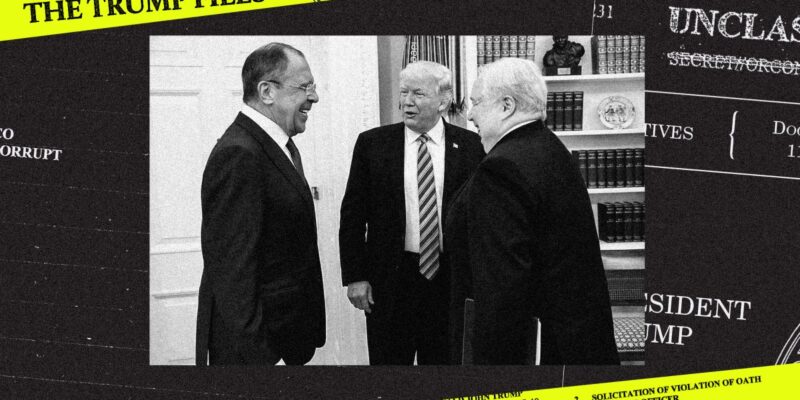
As Donald Trump campaigns to be a dictator for one day, he’s asking: “Are you better off now than you were when I was president?” Great question! To help answer it, our Trump Files series is delving into consequential events from the 45th president’s time in office that Americans might have forgotten—or wish they had.
On May 10, 2017, President Donald Trump hosted two special guests in the Oval Office: Russian foreign minister Sergei Lavrov and Russian ambassador to the US Sergey Kislyak. The meeting was curious. It was closed to American media. No American journalists were allowed to witness it or take photos or video of the meeting. But a Russian photographer was permitted to shoot a few pics, and the Russian government posted them.
There was much else odd about this get-together. Only a few months earlier, the US intelligence community had released a report confirming that Russian leader Vladimir Putin had mounted a covert operation against the United States to help Trump win the 2016 election. The Kremlin’s clandestine warfare had included the cyber-swiping and dissemination, via WikiLeaks, of Democratic emails and documents and a secret social media campaign that sought to sow discord in the United States and boost Trump’s chances of claiming the White House. The hack-and-leak op fomented conflict at the Democrats’ convention and then, in the final month of the race, impeded Hillary Clinton’s campaign by releasing, nearly on a daily basis, internal documents that prompted negative news stories about her and the Democrats. Throughout all this, Trump and his top aides denied Russia was intervening, essentially aiding and abetting Putin by providing cover for him.
Though there were numerous factors that contributed to Clinton’s defeat, the Russian operation was clearly one of them.
After the election, the Kremlin’s intervention and the ties between the Trump campaign and Moscow were the subjects of a federal investigation and congressional inquiries. Trump, though, kept denying Russia had meddled in the race and repeatedly called the whole thing a hoax and a witch hunt. (At the time, it was not yet publicly known that during the campaign his top aides met with a Russian emissary who was introduced to them as a participant in a secret Kremlin project to help Trump win or that Paul Manafort, the chair of the Trump campaign, regularly huddled with a former business associate who was a Russian intelligence officer and shared internal campaign data with him.) Irate about the FBI’s Trump-Russia investigation, Trump, on May 9, 2017, fired the bureau’s director, James Comey.
The following day—with the Comey dismissal dominating the news—Trump warmly greeted the two Russians at the White House. The photo that the Russians released showed the three of them yukking it up. Here was Trump with representatives of a foreign adversary that had attacked an American election, and they appeared to be having a jolly time. And the public wasn’t told what they discussed.
A few days later, the Washington Post reported that during the meeting Trump had revealed highly classified information about a possible Islamic State plot and jeopardized a critical source of intelligence on this terrorist group. According to the newspaper:
The information the president relayed had been provided by a U.S. partner through an intelligence-sharing arrangement considered so sensitive that details have been withheld from allies and tightly restricted even within the U.S. government, officials said.
The partner had not given the United States permission to share the material with Russia, and officials said Trump’s decision to do so endangers cooperation from an ally that has access to the inner workings of the Islamic State.
One intelligence official noted that Trump had “revealed more information to the Russian ambassador than we have shared with our own allies.” Intelligence officials were shocked by this breach.
More about this meeting continued to come out. The New York Times soon reported that Trump had told the Russians that by dismissing Comey he had gotten himself out of a jam: “I just fired the head of the F.B.I. He was crazy, a real nut job. I faced great pressure because of Russia. That’s taken off.” The Times noted how bizarre this was: “The comments represented an extraordinary moment in the investigation, which centers in part on the administration’s contacts with Russian officials: A day after firing the man leading that inquiry, Mr. Trump disparaged him—to Russian officials.”
But there was even more to the meeting that the public wouldn’t learn about for more than two years. In September 2019, the Washington Post revealed that Trump had told Lavrov and Kislyak that he was unconcerned about Moscow’s intervention in the 2016 election and that this assertion had caused alarmed White House officials to limit access to the memo chronicling the conversation.
The Trump White House had fretted about this part of the discussion becoming public. According to the newspaper, the “memorandum summarizing the meeting was limited to a few officials with the highest security clearances in an attempt to keep the president’s comments from being disclosed publicly…White House officials were particularly distressed by Trump’s election remarks because it appeared the president was forgiving Russia for an attack that had been designed to help elect him.”
By the time this part of the conversation was disclosed, Trump was mired in his first impeachment for having pressured the Ukrainian president to dig up dirt on Joe Biden and to find information discrediting the Trump-Russia scandal. And this revelation, like so many about Trump, quickly faded from the national discourse.
It had taken over two years for Americans to learn that Trump had told the Russians he didn’t care about their efforts to subvert a US election. But it was obvious as soon as that original photo was released that Trump had no interest in holding Putin accountable for messing with the election—and for helping him reach the White House.















